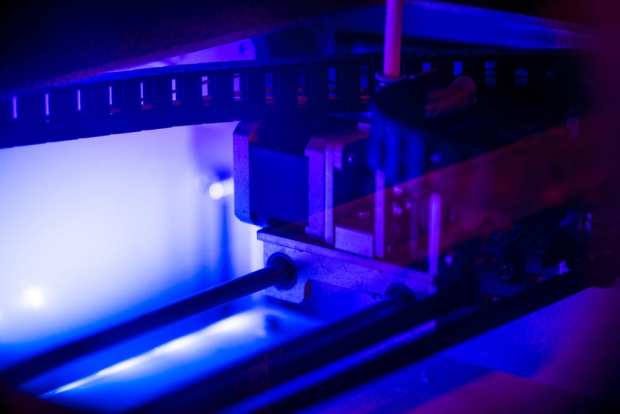Filling The Medical Equipment Gap With The Power Of 3D Printing

Among the many factors aggravating the coronavirus outbreak in the U.S. is an equipment shortage affecting nearly all corners of the United States — particularly when it comes to the available supply of ventilators, testing materials and personal protective equipment (PPE) like masks, blow shields, gloves and gowns.
These items are difficult to find via private channels and through applying to the Strategic National Stockpile.
Wisconsin Gov. Tony Evers has noted the state is still waiting on 190,000 medical masks from FEMA, while North Carolina officials confirmed the state has only received 306 of the 500,000 medical coveralls requested, according to The Washington Post.
New York, the hardest-hit state thus far, has received roughly 4,000 of the 30,000 ventilators state official estimate they will soon need to absorb the demand that is already crashing into hospitals.
And while Gov. Andrew Cuomo has complained in recent days that the lack of coordination between states and federal officials has created the unfortunate situation in which New York finds itself — “on eBay with 50 other states, bidding on a ventilator,” he said — he noted the problem fundamentally is about limited supply and exploding demand. The government cannot distribute resources it does not have.
Filling the gap and getting necessary supplies out there has thus become a priority nationwide — a call that all kinds of private industry players have risen to meet. Neiman Marcus and JOANN are collaborating to create masks, scrubs and surgical gowns, and General Motors is currently sourcing parts so it can turn its assembly line to cranking out 200,000 ventilators.
It’s an impressive response, Jennifer Milne, product marketing lead at Formlabs, told PYMNTS, but there’s a critical problem. The crisis is happening now, and retooling old-school heavy industrial processes to push out a wholly new product is not something that can happen overnight. Given the immediacy of demand, time lag is a problem.
And while it is not a problem that can be easily solved by Formlabs, a global 3D printing hardware firm with a worldwide network of customers and 3D printing equipment, it is a problem they can help mitigate by turning their customer network loose on the problem of 3D printing medical equipment.
“We have many customers in the medical industry already, and we’ve been printing medical supplies for some time,” Milne explained. “So, I think it happened organically with both us internally wondering what we could do as an organization to help and our customers reaching out to us quickly and asking how they could get involved.”
Standardizing Around Safety
There are a variety of products 3D printing can bring to the table, and all of them are incredibly necessary at present. That includes PPE like blow shields, the hard plastic masks doctors wear when they intubate people; nasal swabs for testing kits that are currently is short supply globally; or ventilator splitters, the necessary piece of equipment that, when combined with the right filter, can turn SCUBA gear into a respiratory mask.
And while the temptation can be to just start printing in a frenzy to get things out there in response to the emergency, Milne said, the first phase of this project was actually organizational. Formlabs needed to find a way to match all the requests of equipment coming in with all the customers offering to help join the effort and make sure everything being created is actually useful to the cause.
The company can’t just push designs out and hope for the best when people’s lives literally depend on function; it has to standardize the designs and make sure they are actually safe and up to specs, or there is no purpose in producing them at all.
“We’re working very closely with medical professionals and the community to really validate these 3D designs to prove that they are useful,” she said. “The last thing we wanted to do is encourage people to print something like PPE that is ill-fitting or not functional and is actually putting a care worker at risk. We don’t want people trying to hack things that haven’t been tested.”
That, she noted, can be a complicated effort but one the company is making progress on. Its nasal swabs are ready to be tested, and once they are, production will ramp up. Swabs are in critically short supply as there is only one facility making them in the U.S. The situation has gotten bad enough that the U.S. is airlifting swabs from Italy.
When the company is ready to get printing, she noted, it anticipates 100,000 swabs will be pushed out per day, meaning every 10 days, there will be 1 million more nasal swabs available for testing kits than there otherwise would have been.
Crossing the Chasm
Formlabs, Milne noted, isn’t a comprehensive solution to the equipment shortage plaguing the U.S. at the moment, nor does the company aspire to be. Instead, what the company can do is take some of the pressure off of the immediate crisis and give traditional manufacturing and other channels the time to catch up. It’s a team effort, she said.
But there are a lot of enthusiastic potential teammates out there, she noted. When Formlabs put the call out to their customers to help in the creation of equipment, overnight the company got back over 1,500 responses. These are people whose businesses have shut down or relocated, she said — they’ve packed up their printers or collections of them in a few hours and hauled them home.
The thing in the world they most want to do is help, she said, and they have the technology and tools to do it — even at a small-batch scale.
